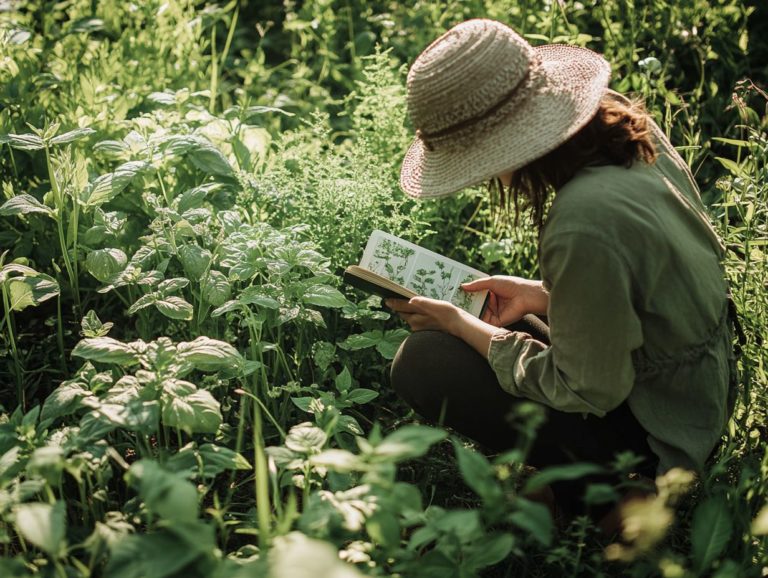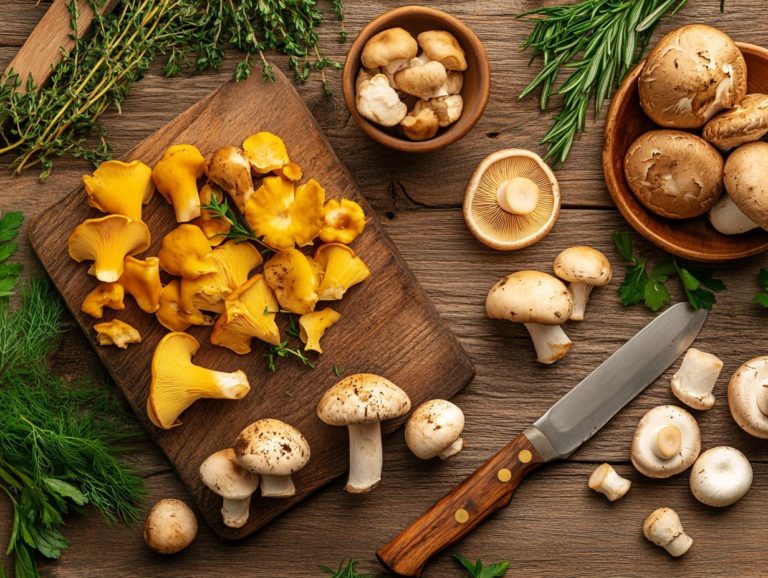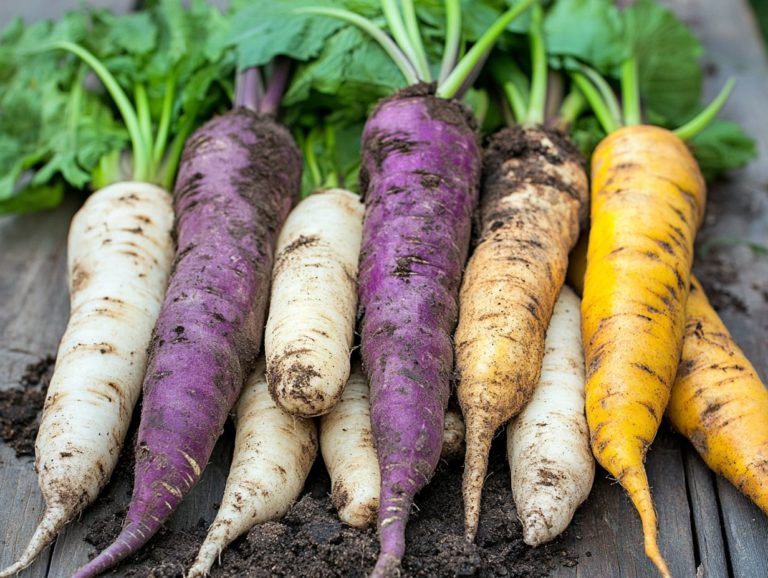Seasonal Edibles: What to Forage in Spring
Foraging in spring is an age-old practice that invites you to reconnect with nature. It offers seasonal delicacies just waiting to be uncovered.
As spring unfolds, the landscape transforms before your eyes, revealing a treasure trove of nutritious edible plants and fungi.
In this article, you ll discover many benefits of foraging in spring, from enhancing your diet with wild edibles to supporting the health of the environment.
You ll be guided on how to identify and safely harvest wild edibles, along with delightful preparation tips and essential safety precautions.
Get ready for a thrilling adventure filled with flavor, with dishes that include delightful wild garlic and morel mushrooms.
Contents
Key Takeaways:

- Foraging in spring helps you eat healthier and connect with nature.
- Learn to identify safe plants to avoid poisonous ones.
- Use your foraged finds in tasty recipes!
What is Foraging and Why Should You Try It?
Foraging is the art of searching for and gathering wild edible plants, such as dandelion and morel mushrooms, in their natural habitat. It s a rewarding endeavor that not only connects you to the great outdoors but also promotes sustainability.
Historically, foraging was a matter of survival. Ancient communities depended on their intimate knowledge of local flora, including medicinal plants, for food and medicine. Today, this time-honored practice is experiencing a renaissance as more individuals seek fresh, organic produce straight from nature, free from harmful pesticides.
The environmental benefits of foraging are compelling. It encourages biodiversity, which is the variety of life in a certain area, and reduces reliance on commercial agriculture. This fosters respect for our ecosystems. As interest swells, many are turning to online foraging courses, which often cover topics like plant identification and backyard foraging. These courses provide a fantastic opportunity for you to learn how to identify edible varieties like stinging nettle and garlic mustard, grasp ethical foraging practices, and help you appreciate nature more.
Benefits of Foraging in Spring
Foraging in spring presents an abundance of advantages, especially as the season unveils a rich tapestry of vibrant green foliage and a diverse range of wild edible plants. During this enchanting time, you can indulge in nutrient-dense delights such as wild garlic, dandelion greens, and morel mushrooms, while also exploring seasonal edibles to forage in summer, elevating your culinary adventures and reaping essential vitamins and minerals.
This season is perfect for embracing the art of seasonal foraging, including the pursuit of fiddlehead ferns and wild asparagus. This fosters a profound connection with nature and promotes sustainable practices that lead to a healthier lifestyle.
Start your foraging journey this spring and discover the flavors waiting for you!
Nutritional and Environmental Benefits
The nutritional benefits of foraging go far beyond simply enhancing the flavor of your meals. Wild edible plants often carry a higher vitamin content, such as vitamins A and C found in stinging nettle, compared to their cultivated counterparts. This contributes significantly to your overall health and wellness.
Take stinging nettle and miner s lettuce, for example; they’re packed with vitamins A and C. Let’s not forget about wild asparagus, which adds unique flavors and textures that elevate your culinary adventures.
Foraging also plays a vital role in fostering environmental awareness and conservation. It invites you to connect with your local ecosystems, deepening your appreciation for biodiversity and native flora. As you learn to identify and sustainably harvest various plants, you’ll discover edible flowers like dandelions. They beautify your plate and deliver essential nutrients such as vitamin K, enhancing your diet’s diversity.
By embracing foraging, you can effectively reduce your carbon footprint, minimizing reliance on commercially farmed produce that often contributes to high transportation emissions. This practice encourages sustainable harvesting methods, safeguarding delicate ecosystems and promoting the preservation of native plant species. Ultimately, you support ecological balance.
Discover the Bounty of Spring

Spring is an exciting time to dive into the world of edible plants and fungi. It calls you to explore a rich tapestry of flavors and textures that nature has to offer. For those new to this adventure, spring foraging for beginners can provide valuable insights. Among the treasures of this season, morel mushrooms stand out, celebrated for their unique and exquisite taste.
You ll also encounter wild garlic and ramps, which infuse your dishes with a delightful garlic essence. Don’t overlook Japanese knotweed this versatile plant can be incorporated into a myriad of culinary delights.
Spring foraging transforms into an exhilarating adventure for any food enthusiast, beckoning you to explore and savor nature’s bounty. For a comprehensive guide, check out what to harvest: seasonal foraging checklist.
Identifying and Harvesting Wild Edibles
Identifying and harvesting wild edible plants are essential skills for you as a forager. Proper plant identification not only ensures your safety but also enhances your overall foraging experience. Whether you’re gathering dandelion roots for a soothing tea or wild violets to elevate your salads, understanding the unique characteristics of each plant is crucial.
A comprehensive foraging guide will be your trusted companion. It offers detailed descriptions and images of wild edible plants, including cleavers and cattail shoots. You’ll also find valuable tips on ethical harvesting practices to promote sustainability, along with insights from summer edibles: top 10 plants to forage this season.
Utilizing mobile apps designed for foraging can take your skills to the next level. These apps help you quickly identify plants and tell you which ones are safe to eat, granting you instant access to information as you explore diverse habitats.
Beyond just identification, embracing ethical harvesting practices is crucial. Always remember to collect only what you need and leave enough plants behind to thrive. This approach conserves local flora and supports ecological balance, ensuring that future foragers can enjoy these wild treasures responsibly.
Safety Precautions for Foraging
Safety precautions are of utmost importance when foraging, especially with the risks associated with poisonous plants like foxglove and hemlock. Familiarizing yourself with common toxic plants is essential to avoid potentially fatal mistakes.
Understanding your foraging environment whether urban or rural will help you pinpoint safe harvesting spots. Utilize trustworthy foraging resources tailored to local edible plants.
Avoiding Poisonous Plants and Contaminated Areas
Avoiding poisonous plants and contaminated areas is vital for safe foraging. It demands your careful observation and a solid foundation of knowledge. Familiarize yourself with hazardous plants, such as the notorious Japanese knotweed. Additionally, conduct thorough research on your foraging locations to ensure you’re not harvesting near pollution sources.
By staying informed about local environmental conditions, including the impacts of chemicals from farming, you can protect yourself against accidental contamination. This makes your foraging experience both safer and more enjoyable.
Understanding how to identify these dangerous plants is essential. For instance, if you spot clusters of white flowers with a distinctive hollow stem, you might be looking at poison hemlock, a highly toxic species. When you choose your foraging spots, consider environmental factors such as proximity to roads, agricultural runoff, or industrial sites, as these areas can harbor harmful contaminants.
It s wise to observe the health of the surrounding vegetation; thriving ecosystems often indicate that the environment is safe for harvesting. By taking these precautions, you’ll be thrilled knowing that the bounty you collect is both delicious and safe for consumption.
Preparing and Cooking Foraged Foods
Preparing and cooking foraged foods unlocks an extraordinary realm of culinary possibilities, inviting you to craft unique dishes that honor the remarkable flavors of nature. Imagine savoring dandelion root coffee or indulging in a comforting stinging nettle soup or nettle tea—there’s a treasure trove of recipes, including seasonal foraging tips that showcase the versatility of wild edibles.
You can elevate your culinary journey by employing techniques such as infusing vinegar with wild garlic or concocting herbal salves from yarrow and leaf balm. These methods enrich the experience and add a touch of adventure to your kitchen.
Recipes and Tips for Using Foraged Ingredients
Developing recipes that incorporate foraged ingredients, such as fermented asparagus, can be both rewarding and creatively fulfilling. Wild edibles introduce unique flavors and impressive nutritional benefits to your meals. Take nettle tea, for instance; it’s a refreshing beverage brimming with vitamins. Or consider fermented asparagus, which adds a delightful tang to salads.
By exploring culinary uses for ingredients like dandelion and chickweed, you ll find inspiration to venture into nature’s pantry. These ingredients not only tantalize your taste buds but also come packed with nutrients, including antioxidants, vitamins A and C, and essential minerals.
When you incorporate foraged elements like wild garlic or elderflowers, balancing their robust flavors with milder components think potatoes or creamy dressings can create a harmonious dish.
For storage, consider drying herbs or pickling vegetables to extend their shelf life and enhance their flavor complexity. Experimenting with seasonal variations of these recipes will keep your meals fresh and exciting, fostering a deeper connection with both the environment and the culinary arts.
Frequently Asked Questions
What are some seasonal edibles that can be foraged in spring?
Some common seasonal edibles that can be foraged in spring include ramps, morel mushrooms, fiddlehead ferns, wild asparagus, and stinging nettles.
How do I identify and safely harvest ramps?
Ramps, also known as wild leeks, have broad, flat leaves and a white bulb with reddish-purple stems. They typically grow in clusters and have a strong onion and garlic flavor. To harvest, gently pull the plant out of the ground, leaving the roots intact, and wash thoroughly before consuming.
Where can I find morel mushrooms in the spring?
Morel mushrooms can be found in wooded areas, especially near trees such as ash, elm, and oak. They prefer moist soil and are often found near fallen logs or decaying plant matter. It’s important to properly identify morels before consuming, as some poisonous look-alike species exist.
How can I cook with fiddlehead ferns?
Fiddlehead ferns have a unique flavor and texture. You can saut , stir-fry, add them to soups, or even pickle them!
Make sure to thoroughly clean and cook fiddleheads before eating. They might carry bacteria from the soil.
Are stinging nettles safe to eat?
Don’t let the name scare you! Stinging nettles are safe to eat when prepared correctly.
The stinging hairs contain formic acid, which can irritate the skin. Wear gloves when harvesting and cook the leaves to remove any sting!
What precautions should I take when gathering seasonal foods in spring?
Always identify wild edibles correctly! Some plants may resemble poisonous species.
Be sure to gather sustainably. Only take what you need and leave some for others.
Be cautious about where you gather. Some areas may contain pesticides or harmful substances.

